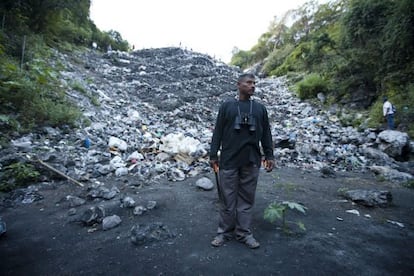The garbage-dump grave of the 43 missing Mexican students
EL PAÍS visits the site where the authorities believe the youths were killed and burned

There is a sudden dip at the end of the road into a deep hollow in the heart of the mountain. According to the Mexican Prosecutor General’s Office, this place, which is only accessible by a winding dirt road, is where the 43 missing student teachers from Ayotzinapa were killed and burned. It has been used as a landfill site for years. A mountain of garbage testifies to its proper function. And, at first glance, it seems like a good place to carry out an extermination.
In order to reach this abyss you need to take a rough journey along a remote road. The trip from Cocula takes 35 minutes in a midsized vehicle. The road slithers through thick vegetation and you often run into cows and mules. It is impossible to go fast for very long and it is difficult to drive at more than 30km/h. There isn’t a single building nearby. Or witness.
The road opens out on to a small terrace that leads to a sharp 20-meter drop. Below, at the foot of a mountain of rubbish, there is a suffocatingly small area of level ground, which still bears the stains from that horrific night. There, according to the Prosecutor General’s Office, the hitmen built a pyre of tires and wood over a circular bed of stones and placed the bodies of the 43 dead students on top. Fed with gasoline, the fire burned for hours, from night to day. But no one saw a thing. No flames, no smoke. Or if they did, they chose not to speak out. Cocula is not a place where you file a complaint against drug trafficking. The bloodthirsty Guerreros Unidos cartel controls the nearby one-horse town of Iguala where the ceilings are low and the eyes kept even lower.
–Go there, if you want, but you’ll be caught by nightfall.
The old indigenous man looks at the visitors with distrust before pointing to the road that leads to the dump site. Like many other places in Guerrero, the site is forbidden. No one goes near it. And everyone knows why. But something has changed this afternoon. A group of cars is coming up the road. The sun is setting and they seem to be in a hurry. A dozen men, many of them community vigilantes, quickly get down and look carefully at the journalists’ car, parked next to the garbage site. Among them are the fathers of two students. They have come to see the terrain. The relatives, escorted by vigilantes, approach the abyss slowly. They stand above the trash heap and peer down into the hollow. For an instant, they seem defeated, absorbed in looking over the ashes. Then, one of them mumbles: “It cannot be, my son is still alive.”
Fed with gasoline, the fire burned for hours. But no one saw a thing. Or if they did, they chose not to speak out
Eduardo Bartolo’s father is carrying a machete; a pair binoculars hang from his neck. He has not heard anything about his son for more than 40 days. Wearing rope-soled sandals, he has a hard time getting down the side of the hill, which is covered with plastic bags, old TV sets and glass. Here, in the middle of this desolate place, his boy was supposedly killed along with 42 of his classmates. The father walks over the burned surface, absorbed in his thoughts. He tries to recreate what happened during those early morning hours at the scene of the event. Young men killing young men. His first reaction, denial, turns into doubt. “It hurts me to think that he might have felt alone if it happened here. Where was I?” he thinks aloud. He walks between shadows and ghosts, and the voices that echo in the natural pot of earth formed by the walls of this hill surrounding the site. Speaking very low, he says something. He then unsheathes the machete and moves a little mound of dirt to his right: “I am looking for his shirt, a sign. Something.” Abraham de la Cruz’s father who was by his side during the tour, speaks to him as well as to himself: “I don’t think it was here. I don’t believe it, no.”
The men arrived at the garbage site in vans belonging to Unión de Pueblos y Organizaciones del Estado de Guerrero (UPOEG), a group of armed peasants who helped in the fruitless search for the students. Miguel Ángel Jiménez, one of the leaders, inspects the place and moves his head from side to side, saying no, no. The group around him picks up the message and they begin to thread sentences like “it was not here,” “the bones they found must have been cows,” “these cops have seen a lot of soap operas.”
The fathers hold a long silence. And darkness falls.
Translation: Dyane Jean François
Tu suscripción se está usando en otro dispositivo
¿Quieres añadir otro usuario a tu suscripción?
Si continúas leyendo en este dispositivo, no se podrá leer en el otro.
FlechaTu suscripción se está usando en otro dispositivo y solo puedes acceder a EL PAÍS desde un dispositivo a la vez.
Si quieres compartir tu cuenta, cambia tu suscripción a la modalidad Premium, así podrás añadir otro usuario. Cada uno accederá con su propia cuenta de email, lo que os permitirá personalizar vuestra experiencia en EL PAÍS.
En el caso de no saber quién está usando tu cuenta, te recomendamos cambiar tu contraseña aquí.
Si decides continuar compartiendo tu cuenta, este mensaje se mostrará en tu dispositivo y en el de la otra persona que está usando tu cuenta de forma indefinida, afectando a tu experiencia de lectura. Puedes consultar aquí los términos y condiciones de la suscripción digital.








































